14 Ways To Experience French Culture In New Orleans
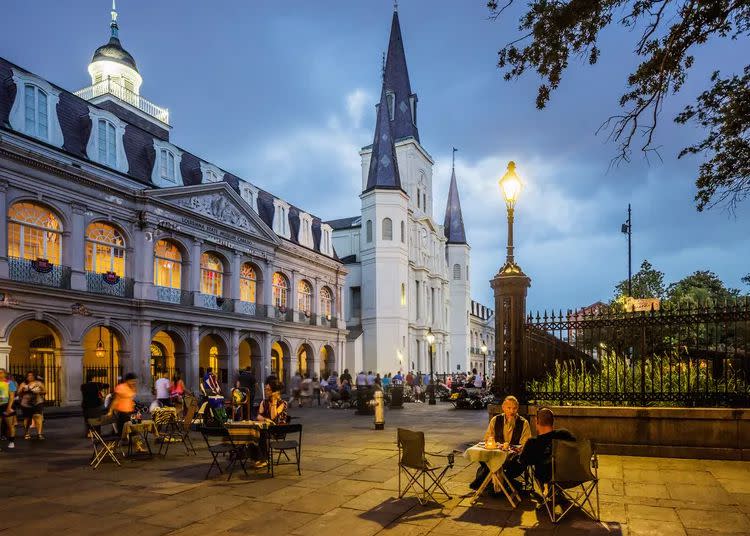
The Cabildo
New Orleans is a cultural powerhouse, blending French, Spanish, African, and American traditions to create one of the best food and music scenes in the country. When you think of New Orleans, chances are you associate the city with all things French.
Francophone—a term used to describe cultures, peoples, and languages influenced by France—activities and celebrations have seen a resurgence in recent years. From Joan of Arc celebrations to French language classes, Creole cuisine to French film festivals, New Orleanians are proud of their more than 300 years of history.
“Every time a new group of people settled in this region, they made a cultural impact on the city. It is a beautiful mix of a lot of different people here,” says Amanda McFillen, Director of Programs and Interpretive Services for The Historic New Orleans Collection.
The French were the first Europeans to colonize New Orleans, which remained under French rule until 1763, when the area became a Spanish colony. In 1803, Louisiana became an American territory. The city’s French roots grew deeper as waves of French-speaking immigrants from Canada (whose descendants are known as Cajuns) and Haiti settled in the area. Over time, Caribbean, Italian, German, and Irish immigrants; enslaved Africans; and free people of color all contributed rich traditions and culture to the region. The term Creole represents this ancestral complexity of many long-time residents of New Orleans.
In the French Quarter, or Vieux Carré, you can walk through these eras of history. The quarter was originally constructed according to French custom but was later renovated by the Spanish following extensive fires in the 18th century. For over a century, the French Quarter remained linguistically and culturally isolated from the rest of the city, contributing to the distinct architecture and traditions we see today. Even outside of the quarter, though, the influence of New Orleans’ many inhabitants is clear. “New Orleans is a city that sort of punches above its weight,” says Joseph Mistrot, the president of Franco-Louisiana organization L'Union Française. “There's way more cultural things to do here than you would expect in a city of its size.”
Here are some of the best ways to experience French culture in New Orleans, no matter when you're visiting.
Related: The Best Time To Visit New Orleans For Every Type Of Traveler
Historical Landmarks
Relish the History of Jackson Square
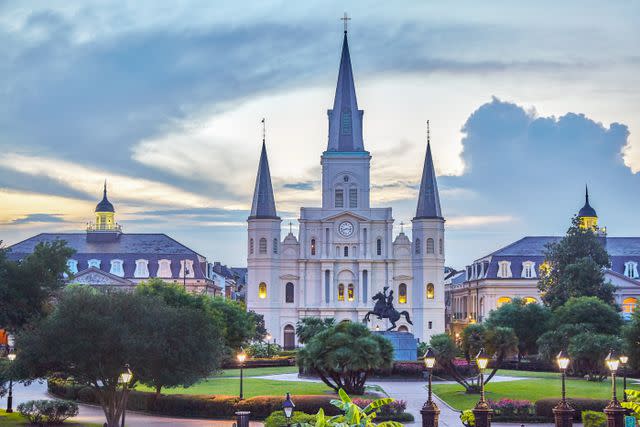
Getty
Standing in the center of Jackson Square, you’ll revel in the shadow of the St. Louis Cathedral, the oldest Catholic cathedral in continual use in the United States. French Catholics built the cathedral building in 1718, the early days of the French colony, and French services were routinely held until at least 1906. As you walk down the cathedral's nave, you'll pass the burial places of numerous French settlers who took up positions in the church.
Outside again, if you turn to face the cathedral and look to your left and right, you’ll see distinctive red brick buildings stretch down the square. These are the Pontalba Buildings, named after a wealthy 19th-century French family.
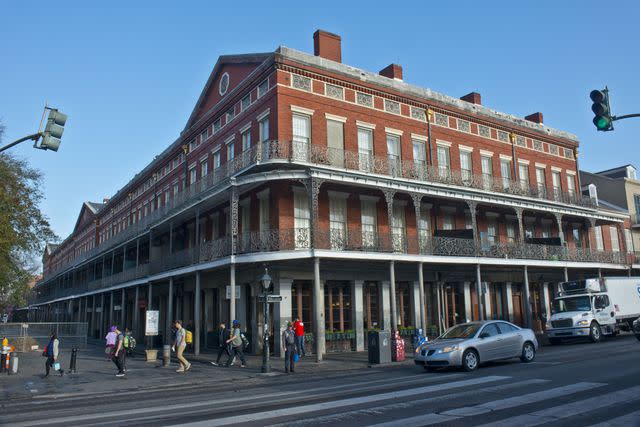
Getty
The Baroness de Pontalba was from New Orleans but lived most of her dramatic adult life in Paris. Using her expertise in business and architecture, she decided to construct the buildings on inherited land. Engraved initials on the wrought iron balconies – AP for Almonester de Pontalba — cement her influence.
Experience 19th-century New Orleans at the BK House
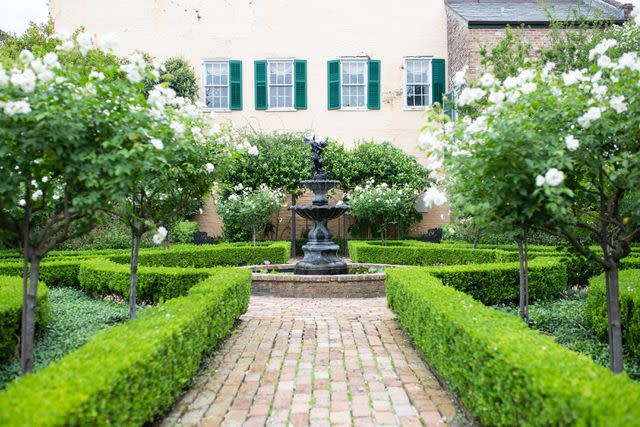
The BK House, short for Beauregard-Keyes, is a National Historic Landmark in the French Quarter. Built in 1826, the house provides a glimpse into the lives of numerous pre-civil war French Creoles and laborers. The house was designed by Haitian architect Francois Correjolles, who utilized elements of a Creole cottage with Greek Revival features—a common architectural style to look out for in French Quarter. The house currently serves as the headquarters of the Nous Foundation, a Francophone cultural institute, and features an exhibition inspired by Haitian art.
Experience French Impressionist Art at the Degas House
At the Degas House, guests have the opportunity to experience Creole food and culture as it was experienced by French Impressionist Master, Edgar Degas, who stayed on the property for four months in the late nineteenth century. Non-inn guests can also enjoy a Creole breakfast, complete with French Waffles and oversized Creole omelets, and a history-focused house tour.
Learning Opportunities
Discover the France-New Orleans Link at The Historic New Orleans Collection
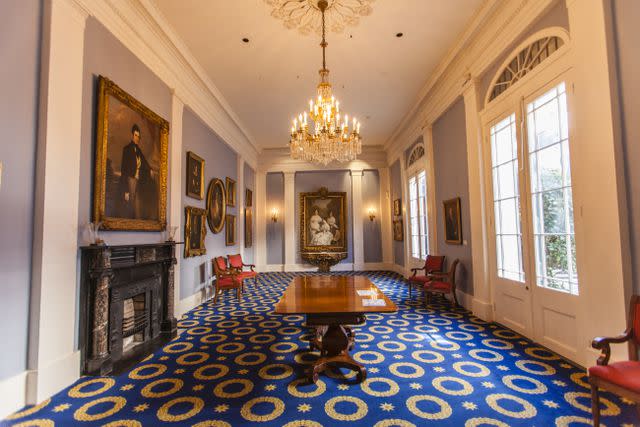
Getty
The drawing room in Counting House Interior of the Historic New Orleans Collection.Located in a historic building in the heart of the French Quarter, the Historic New Orleans Collection is a free history museum, research center, and publisher. Through their permanent exhibit, learn about the history of the French Quarter, from its construction by French settlers to its post-fire reconstruction by the Spanish. Then explore the museum's other permanent and temporary exhibits—as well as an exposed historic well.
Uncover History at Le Musée de f.p.c.
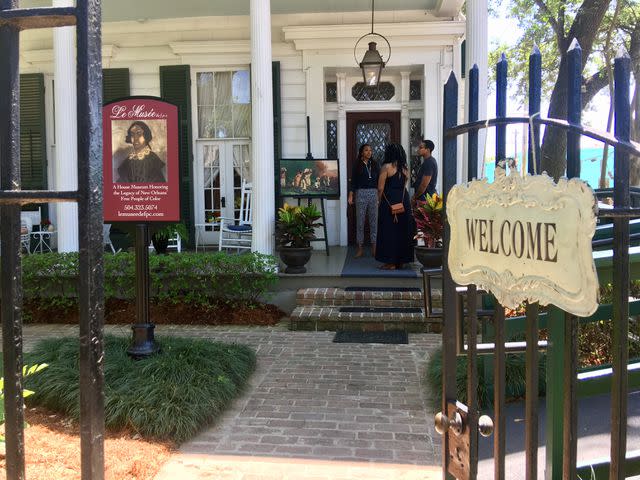
Le Musée de f.p.c.
Continue your stroll through history at Le Musée de f.p.c., located just down the street from the Degas House. New Orleans has a long history of free people of color who spoke French and were Creoles, also referred to as gens de couleur libres. The historic house is constructed in the same Greek Revival style as the BK house, and the museum represents one of the country's only museums dedicated exclusively to telling the story of free people of color.
See the European-American Land Struggle at the State Museums
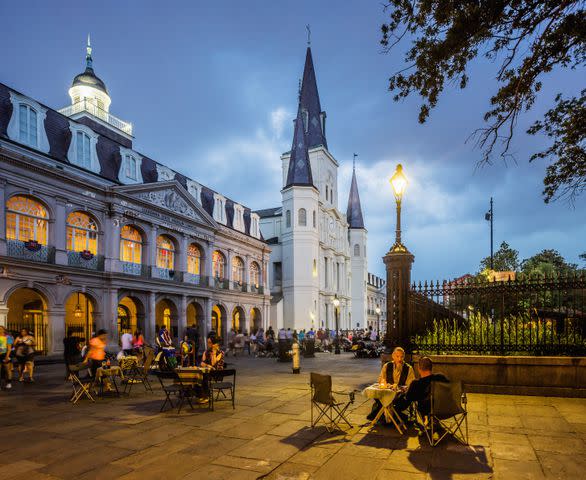
Getty
The Cabildo, the site of one of the Louisiana State Museums.Two of Louisiana’s official museums are housed in the Cabildo and Presbytère, the two buildings on either side of the St. Louis Cathedral in Jackson Square. Over 200 years ago, France officially relinquished ownership of Louisiana during a ceremony in the Cabildo—the Louisiana Purchase. The Cabildo now hosts an exhibit on The Battle of New Orleans, when the British and their Spanish allies invaded the city because they did not recognize land deals made by the French Emperor Napoleon Bonaparte, as well as an exhibit on “people, places, and things that are quintessentially New Orleans.” The Presbytère also features two permanent exhibits: Mardi Gras: It’s Carnival Time in Louisiana and Living with Hurricanes: Katrina and Beyond.
Test Your Skills with French Language Classes
Whether you’re fluent or un amateur, multiple organizations offer French language groups to improve your skills—and, as an added benefit, get to know city residents involved in francophone events. If you’re staying for a while, L'Union Française offers three-week French immersion classes. Alliance Française of New Orleans also offers French classes for all skill levels, as well as an informal French conversation group.
French Cuisine
Dine with (Friendly) French Ghosts at Antoine's Restaurant

Getty
Taste history at Antoine's Restaurant, one of the oldest restaurants in the country. Try their famous Bananas Foster, a French toast dish topped with caramelized bananas and lit on fire at your table. After dinner, order an infamous French cocktail: a Cafe Brulot. The coffee cocktail involves boiling coffee with herbs and spices, adding an orange peel, and then lighting the concoction on fire to burn off some of the liquor and add a smokey flavor.
Treat Your Tastebuds to Dooky Chase
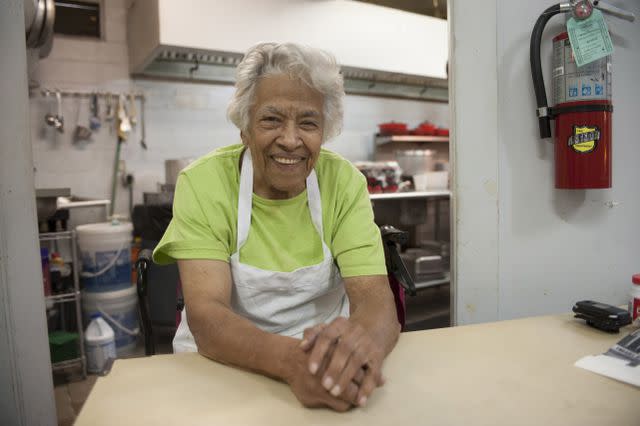
This legendary Creole restaurant, which once served as an important gathering place for activists during the Civil Rights Movement, makes a fine gumbo. Like most Creole foods, the dish is believed to blend West African, Native American, and French culinary traditions. As you eat, enjoy what many consider New Orleans’ finest collection of African American Art. Dooky Chase co-founder Leah Chase, who recently passed away in her 90s, was an inspiration for Princess Tiana from Disney's Princess and The Frog.
Revel in L'air de Paris at Cafe Degas
Toast the day at Cafe Degas, a romantic French bistro. When painter Edgar Degas (mentioned in the Degas House section above) spent time as a young man in New Orleans, he lived close to the restaurant’s current location. Allison Alsup, Alsup, a local writer who moved to New Orleans 23 years ago because of the city's Francophone culture, described the cafe as having an “indoor-outdoor feel” and recommended prefacing your cafe visit with the nearby New Orleans Museum of Art for a truly Paris-esque experience.
Taste Wines and French Cheeses at St. James Cheese Company
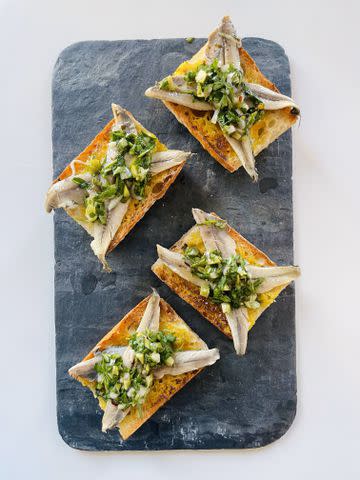
If you're eager to experience all the flavors France can offer, head to St. James Cheese Company and order their French Collection. Or, if you're on the go, order the cheese for pickup and enjoy it in the comfort of your hotel room. If you're coming from the French Film Festival, one of the company's locations is just across the street.
Enjoy Famous French Pastries at La Boulangerie
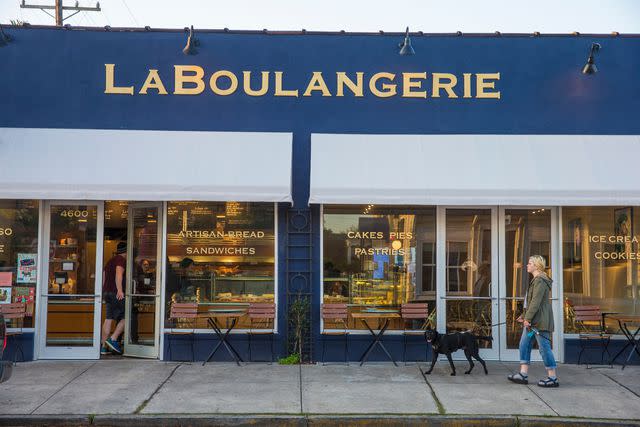
Chris Granger
For an experience "very evocative of a French bakery," check out La Boulangerie. If you're visiting for lunch, try the Croque Monsieur, the fanciest-sounding ham and cheese sandwich on this side of the Mississippi (no surprise—it's French). For lighter fare, try one of the cafe's many croissant flavors. Unless you're staying for a while, it's unlikely you'll even make a dent in the bakery's pastry and bread options.
Treat Yourself to Cajun at Cochon

Cochon is a must for some of the city's best Cajun. Cajun food, or cuisine cadienne in French, traces its roots back to rural France. Cochon's menu includes many meat and vegetable dishes inspired by the peasant-style recipes and culinary traditions originally brought to North America by Acadians, including a pork neck cutlet with pickled greens and Louisiana cochon (pig) with braised green beans and pickled pears.
Related: The 40 Best Restaurants In New Orleans For Every Price Point
French Celebrations
Observe Francophonie at the French Film Festival
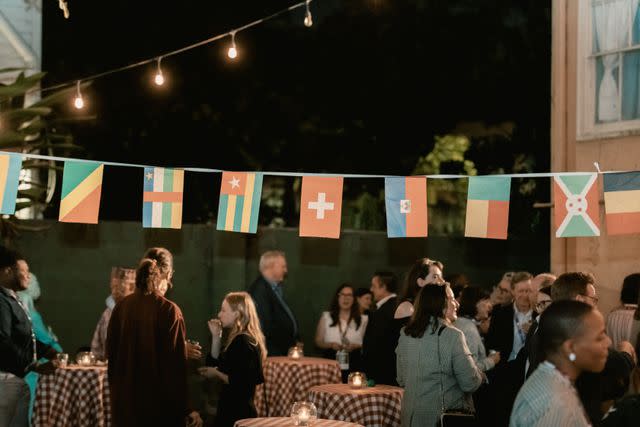
Kewon Hunter
The Patron Party at the French Film Festival.2024 marks the 27th New Orleans French Film Festival, held in-person February 22-28 and virtually from February 22-March 3. L'Union Française, one of the major sponsors of the event, hosts a coffee and croissants event in association with the festival, during which attendees can enjoy live French-inspired cajun music. Though the films use French language audio, all are offered with English subtitles.
Experience a Joan of Arc Parade
Amy Kirk Duvoisin, who founded the Joan of Arc parade, describes it as a less overwhelming version of Mardi Gras. The parade, which has been described as a “Walking Renaissance Festival,” has evolved into a celebration of Francophone culture in New Orleans, a “magnet for the French community.”
Celebratory exclamations in French abound in the streets, where performers dressed as angels, flowers, and French medieval characters march (on foot or on horse). “You get a very authentic French experience, but then you also get this artistry of a New Orleans street parade and the irreverence of Mardi Gras,” says Kirk Duvoisin. According to Kirk Duvoisin, the most French component of the parade happens early on, when the Consul General of France in New Orleans toasts the parade in French, followed by a toast from the New Orleans Mayor in English.
Visitors can also tour New Orleans' Joan of Arc statue, lovingly referred to as "Joanie on the Pony" by locals. The statue is an exact copy of the famous 1880 Emmanual Fremiet equestrian statue of Joan located at Place des Pyramides, Paris. It was gifted to the city by then-French President Charles Degaulle in 1964 and continues to serve as a reminder of the city's connections to France.
Commemorate Bastille Day
If you find yourself in New Orleans in the dead of summer, Alsup says you can’t miss the festivities of Bastille Day, the anniversary of a prison break representing the beginning of the French Revolution. In past years, performers have celebrated rebellious French women through dance, DJ-ed in French style, and immersed visitors with jazz music.
Related: The Best Places To Shop In New Orleans
For more Southern Living news, make sure to sign up for our newsletter!
Read the original article on Southern Living.

